p-Type Schottky Contacts for Graphene Adjustable-Barrier Phototransistors
Abstract
1. Introduction
2. Materials and Methods
3. Results and Discussion
3.1. Design Considerations of the Proposed Photo-GABT and Its Potential Performance
3.2. p-Type Schottky Junctions for the Photo-GABT
3.2.1. Graphene on p-Germanium
3.2.2. p-Silicon on Graphene
3.3. Comparison of Phototransistor Performances
4. Conclusions
5. Patents
Author Contributions
Funding
Data Availability Statement
Conflicts of Interest
Appendix A
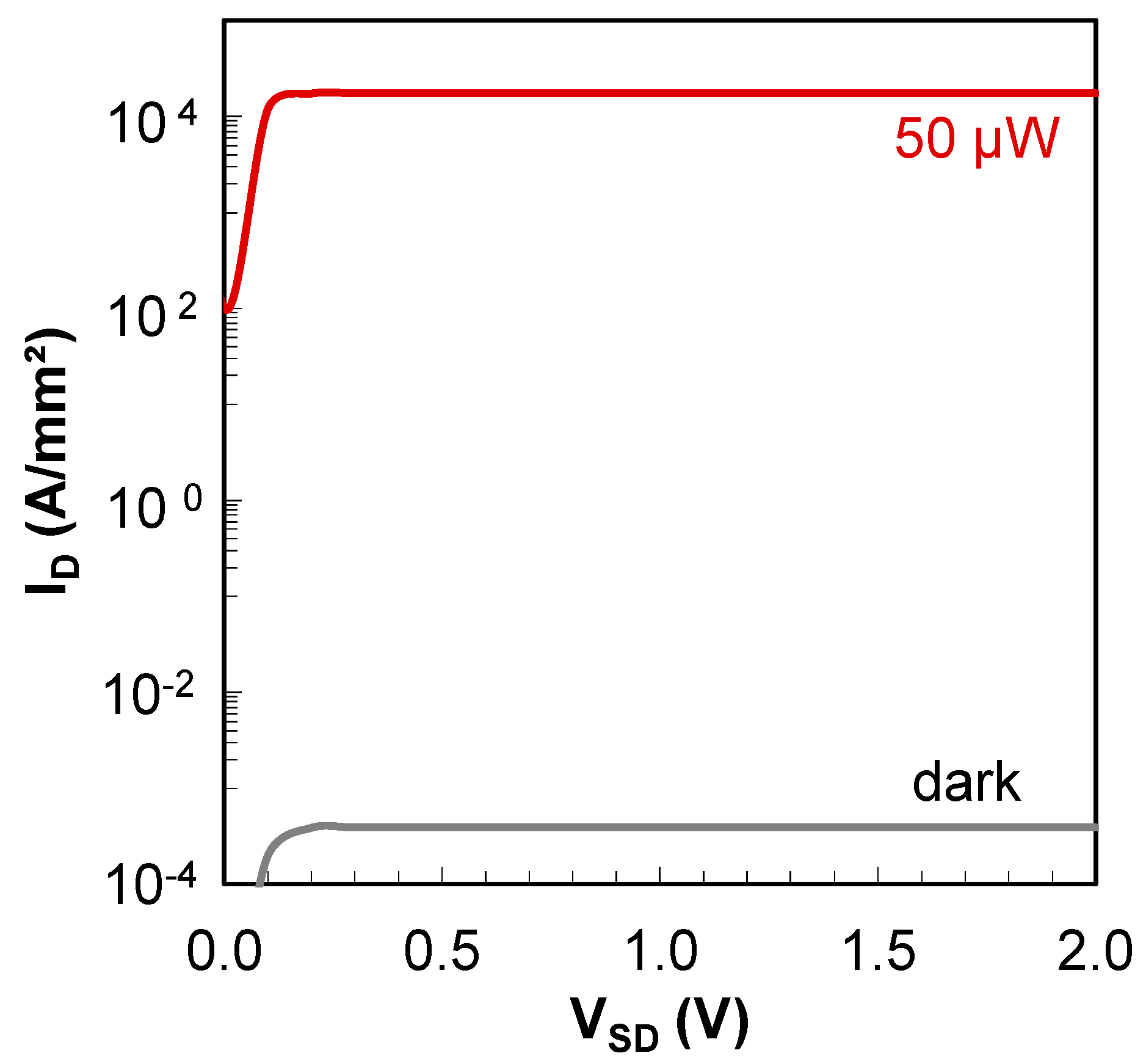

Appendix B
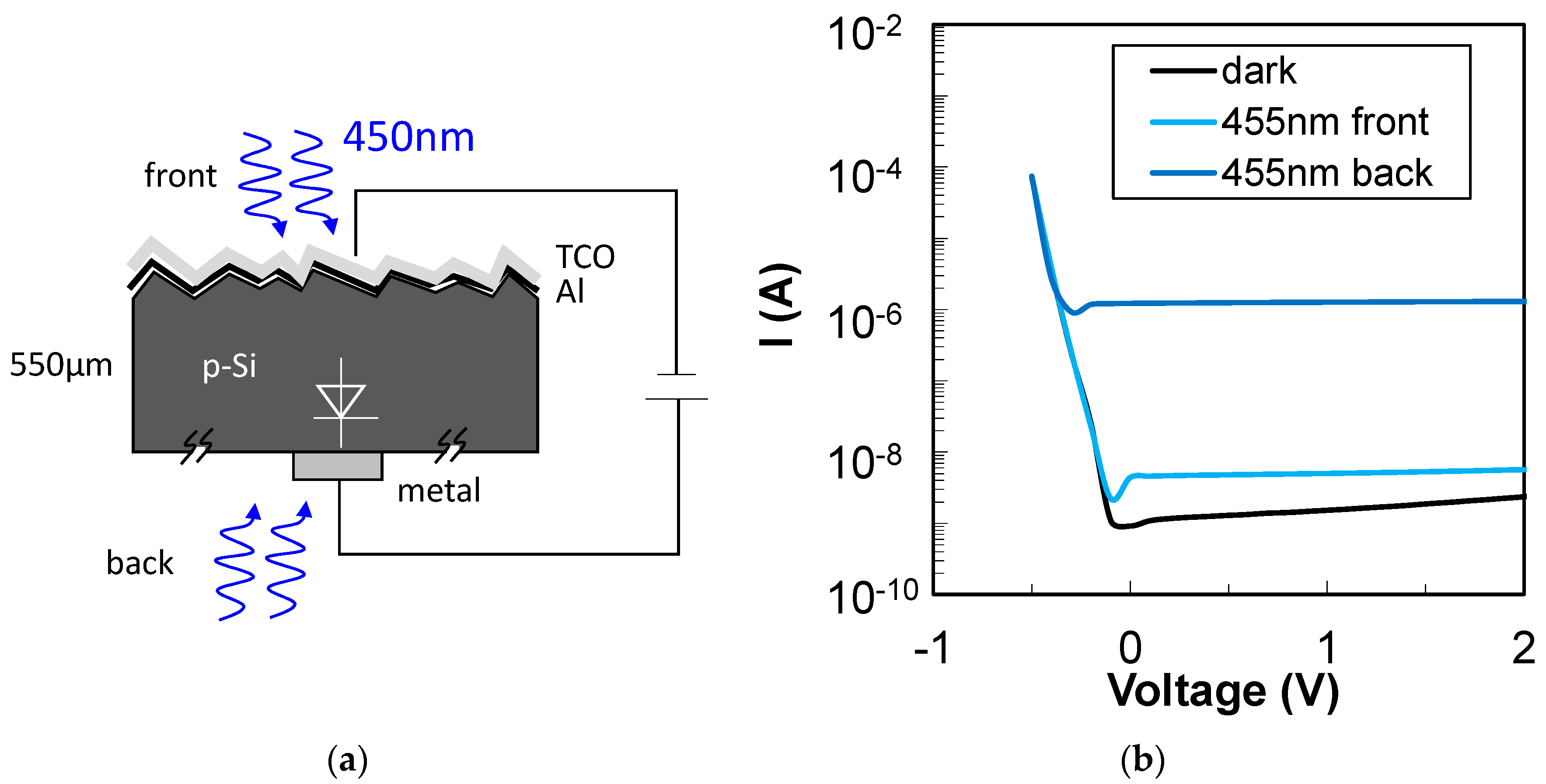

References
- Chen, G.; Yu, Y.; Shi, Y.; Li, N.; Luo, W.; Cao, L.; Danner, A.J.; Liu, A.-Q.; Zhang, X. High-Speed Photodetectors on Silicon Photonics Platform for Optical Interconnect. Laser Photonics Rev. 2022, 16, 2200117. [Google Scholar] [CrossRef]
- Rouvalis, E.; Chtioui, M.; van Dijk, F.; Lelarge, F.; Fice, M.J.; Renaud, C.C.; Carpintero, G.; Seeds, A.J. 170 GHz Uni-Traveling Carrier Photodiodes for InP-Based Photonic Integrated Circuits. Opt. Express OE 2012, 20, 20090–20095. [Google Scholar] [CrossRef] [PubMed]
- Lischke, S.; Peczek, A.; Morgan, J.S.; Sun, K.; Steckler, D.; Yamamoto, Y.; Korndörfer, F.; Mai, C.; Marschmeyer, S.; Fraschke, M.; et al. Ultra-Fast Germanium Photodiode with 3-dB Bandwidth of 265 GHz. Nat. Photon. 2021, 15, 925–931. [Google Scholar] [CrossRef]
- Koepfli, S.M.; Baumann, M.; Koyaz, Y.; Gadola, R.; Güngör, A.; Keller, K.; Horst, Y.; Nashashibi, S.; Schwanninger, R.; Doderer, M.; et al. Metamaterial Graphene Photodetector with Bandwidth Exceeding 500 Gigahertz. Science 2023, 380, 1169–1174. [Google Scholar] [CrossRef] [PubMed]
- Li, W.; Liu, M.; Cheng, S.; Zhang, H.; Yang, W.; Yi, Z.; Zeng, Q.; Tang, B.; Ahmad, S.; Sun, T. Polarization Independent Tunable Bandwidth Absorber Based on Single-Layer Graphene. Diam. Relat. Mater. 2024, 142, 110793. [Google Scholar] [CrossRef]
- Jiang, B.; Hou, Y.; Wu, J.; Ma, Y.; Gan, X.; Zhao, J. In-Fiber Photoelectric Device Based on Graphene-Coated Tilted Fiber Grating. OES 2023, 2, 230012. [Google Scholar] [CrossRef]
- Konstantatos, G.; Badioli, M.; Gaudreau, L.; Osmond, J.; Bernechea, M.; de Arquer, F.P.G.; Gatti, F.; Koppens, F.H.L. Hybrid Graphene–Quantum Dot Phototransistors with Ultrahigh Gain. Nat. Nanotech 2012, 7, 363–368. [Google Scholar] [CrossRef] [PubMed]
- Strobel, C.; Chavarin, C.A.; Richter, K.; Knaut, M.; Reif, J.; Völkel, S.; Jahn, A.; Albert, M.; Wenger, C.; Kirchner, R.; et al. Novel Graphene Adjustable-Barrier Transistor with Ultra-High Current Gain. ACS Appl. Mater. Interfaces 2022, 14, 39249–39254. [Google Scholar] [CrossRef] [PubMed]
- Strobel, C.; Chavarin, C.A.; Wenger, C.; Albert, M.; Mikolajick, T. Vertical Graphene-Based Transistors for Power Electronics, Optoelectronics and Radio-Frequency Applications. In Proceedings of the 2023 IEEE Nanotechnology Materials and Devices Conference (NMDC), Paestum, Italy, 23–25 October 2023; pp. 196–201. [Google Scholar]
- Strobel, C.; Chavarin, C.A.; Knaut, M.; Völkel, S.; Albert, M.; Hiess, A.; Max, B.; Wenger, C.; Kirchner, R.; Mikolajick, T. High Gain Graphene Based Hot Electron Transistor with Record High Saturated Output Current Density. Adv. Electron. Mater. 2024, 10, 2300624. [Google Scholar] [CrossRef]
- Liu, C.; Ma, W.; Chen, M.; Ren, W.; Sun, D. A Vertical Silicon-Graphene-Germanium Transistor. Nat. Commun. 2019, 10, 4873. [Google Scholar] [CrossRef]
- Strobel, C.; Chavarin, C.A.; Völkel, S.; Jahn, A.; Hiess, A.; Knaut, M.; Albert, M.; Wenger, C.; Steinke, O.; Stephan, U.; et al. Enhanced Electrical Properties of Optimized Vertical Graphene-Base Hot Electron Transistors. ACS Appl. Electron. Mater. 2023, 5, 1670–1675. [Google Scholar] [CrossRef]
- Strobel, C.; Chavarin, C.A.; Kitzmann, J.; Lupina, G.; Wenger, C.; Albert, M.; Bartha, J.W. Towards High Frequency Heterojunction Transistors: Electrical Characterization of N-Doped Amorphous Silicon-Graphene Diodes. J. Appl. Phys. 2017, 121, 245302. [Google Scholar] [CrossRef]
- Strobel, C.; Chavarin, C.A.; Leszczynska, B.; Leszczynski, S.; Winkler, F.; Killge, S.; Völkel, S.; Richter, K.; Hiess, A.; Knaut, M.; et al. Demonstration of a Graphene-Base Heterojunction Transistor with Saturated Output Current. J. Appl. Phys. 2019, 125, 234501. [Google Scholar] [CrossRef]
- Bartolomeo, A.D.; Luongo, G.; Iemmo, L.; Urban, F.; Giubileo, F. Graphene–Silicon Schottky Diodes for Photodetection. IEEE Trans. Nanotechnol. 2018, 17, 1133–1137. [Google Scholar] [CrossRef]
- Song, S.; Kim, S.-H.; Han, K.-H.; Kim, H.; Yu, H.-Y. In-Depth Analysis on Self Alignment Effect of the Fermi-Level Using Graphene on Both n- and p-Type Semiconductors. ACS Appl. Mater. Interfaces 2023, 15, 57879–57889. [Google Scholar] [CrossRef] [PubMed]
- Pea, M.; De Seta, M.; Di Gaspare, L.; Persichetti, L.; Scaparro, A.M.; Miseikis, V.; Coletti, C.; Notargiacomo, A. Submicron Size Schottky Junctions on As-Grown Monolayer Epitaxial Graphene on Ge(100): A Low-Invasive Scanned-Probe-Based Study. ACS Appl. Mater. Interfaces 2019, 11, 35079–35087. [Google Scholar] [CrossRef] [PubMed]
- Luongo, G.; Bartolomeo, A.D.; Giubileo, F.; Chavarin, C.A.; Wenger, C. Electronic Properties of Graphene/p-Silicon Schottky Junction. J. Phys. D Appl. Phys. 2018, 51, 255305. [Google Scholar] [CrossRef]
- Yang, H.; Heo, J.; Park, S.; Song, H.J.; Seo, D.H.; Byun, K.-E.; Kim, P.; Yoo, I.; Chung, H.-J.; Kim, K. Graphene Barristor, a Triode Device with a Gate-Controlled Schottky Barrier. Science 2012, 336, 1140–1143. [Google Scholar] [CrossRef] [PubMed]
- Khurelbaatar, Z.; Kil, Y.-H.; Shim, K.-H.; Cho, H.; Kim, M.-J.; Kim, Y.-T.; Choi, C.-J. Temperature Dependent Current Transport Mechanism in Graphene/Germanium Schottky Barrier Diode. JSTS J. Semicond. Technol. Sci. 2015, 15, 7–15. [Google Scholar] [CrossRef]
- Narasinha, S.; Rohatgi, A. Optimized Aluminum Back Surface Field Techniques for Silicon Solar Cells. In Proceedings of the Conference Record of the Twenty Sixth IEEE Photovoltaic Specialists Conference-1997, Anaheim, CA, USA, 29 September–3 October 1997; pp. 63–66. [Google Scholar]
- Voronkov, V.V.; Falster, R.; Bothe, K.; Lim, B.; Schmidt, J. Lifetime-Degrading Boron-Oxygen Centres in p-Type and n-Type Compensated Silicon. J. Appl. Phys. 2011, 110, 063515. [Google Scholar] [CrossRef]
- Chen, C.-C.; Aykol, M.; Chang, C.-C.; Levi, A.F.J.; Cronin, S.B. Graphene-Silicon Schottky Diodes. Nano Lett. 2011, 11, 1863–1867. [Google Scholar] [CrossRef]
- An, Y.; Behnam, A.; Pop, E.; Bosman, G.; Ural, A. Forward-Bias Diode Parameters, Electronic Noise, and Photoresponse of Graphene/Silicon Schottky Junctions with an Interfacial Native Oxide Layer. J. Appl. Phys. 2015, 118, 114307. [Google Scholar] [CrossRef]
- Dalla Betta, G.F.; Pignatel, G.U.; Verzellesi, G.; Bellutti, P.; Boscardin, M.; Ferrario, L.; Zorzi, N.; Maglione, A. Design and Optimization of an Npn Silicon Bipolar Phototransistor for Optical Position Encoders. Microelectron. J. 1998, 29, 49–58. [Google Scholar] [CrossRef]
- Gao, Y.; Das, R.; Xie, Y.; Guo, F.; Mascher, P.; Knights, A.P. Si/Ge Phototransistor with Responsivity > 1000 A/W on a Silicon Photonics Platform. Opt. Express OE 2024, 32, 2271–2280. [Google Scholar] [CrossRef]
- Ko, W.S.; Bhattacharya, I.; Tran, T.-T.D.; Ng, K.W.; Adair Gerke, S.; Chang-Hasnain, C. Ultrahigh Responsivity-Bandwidth Product in a Compact InP Nanopillar Phototransistor Directly Grown on Silicon. Sci. Rep. 2016, 6, 33368. [Google Scholar] [CrossRef]
- Han, T.; Shou, M.; Liu, L.; Xie, Z.; Ying, L.; Jiang, C.; Wang, H.; Yao, M.; Deng, H.; Jin, G.; et al. Ultrahigh Photosensitive Organic Phototransistors by Photoelectric Dual Control. J. Mater. Chem. C 2019, 7, 4725–4732. [Google Scholar] [CrossRef]
- Xu, J.; Luo, X.; Hu, S.; Zhang, X.; Mei, D.; Liu, F.; Han, N.; Liu, D.; Gan, X.; Cheng, Y.; et al. Tunable Linearity of High-Performance Vertical Dual-Gate vdW Phototransistors. Adv. Mater. 2021, 33, 2008080. [Google Scholar] [CrossRef]
- Moudgil, A.; Sharma, S.; Das, S. In2Se3/Silicon-on-Insulator Heterojunction Phototransistor for Low Noise Dual-Band Detection. IEEE Electron Device Lett. 2021, 42, 755–758. [Google Scholar] [CrossRef]
- Chen, T.; Zhang, J.; Zhang, X.; Chen, C.; Zhang, L.; Hu, Y.; Ma, Y.; Wei, X.; Zhou, X.; Tang, W.; et al. Ultrahigh Responsivity β-Ga2O3/BP Junction Field Effect Phototransistors for UV/IR Dual-Band Detection. IEEE Sens. J. 2023, 23, 15504–15511. [Google Scholar] [CrossRef]
- Li, S.; Wu, Q.; Ding, H.; Wu, S.; Cai, X.; Wang, R.; Xiong, J.; Lin, G.; Huang, W.; Chen, S.; et al. High Gain, Broadband p-WSe2/n-Ge van Der Waals Heterojunction Phototransistor with a Schottky Barrier Collector. Nano Res. 2023, 16, 5796–5802. [Google Scholar] [CrossRef]
- Li, J.; Niu, L.; Zheng, Z.; Yan, F. Photosensitive Graphene Transistors. Adv. Mater. 2014, 26, 5239–5273. [Google Scholar] [CrossRef]
- Pasternak, I.; Wesolowski, M.; Jozwik, I.; Lukosius, M.; Lupina, G.; Dabrowski, P.; Baranowski, J.M.; Strupinski, W. Graphene Growth on Ge(100)/Si(100) Substrates by CVD Method. Sci. Rep. 2016, 6, 21773. [Google Scholar] [CrossRef]
- Wang, G.; Zhang, M.; Zhu, Y.; Ding, G.; Jiang, D.; Guo, Q.; Liu, S.; Xie, X.; Chu, P.K.; Di, Z.; et al. Direct Growth of Graphene Film on Germanium Substrate. Sci. Rep. 2013, 3, 2465. [Google Scholar] [CrossRef]
- Jacobberger, R.M.; Savage, D.E.; Zheng, X.; Sookchoo, P.; Rojas Delgado, R.; Lagally, M.G.; Arnold, M.S. Effect of Germanium Surface Orientation on Graphene Chemical Vapor Deposition and Graphene-Induced Germanium Nanofaceting. Chem. Mater. 2022, 34, 6769–6778. [Google Scholar] [CrossRef]
- Schneider, M.V. Schottky Barrier Photodiodes with Antireflection Coating. Bell Syst. Tech. J. 1966, 45, 1611–1638. [Google Scholar] [CrossRef]
- Luongo, G.; Giubileo, F.; Genovese, L.; Iemmo, L.; Martucciello, N.; Di Bartolomeo, A. I-V and C-V Characterization of a High-Responsivity Graphene/Silicon Photodiode with Embedded MOS Capacitor. Nanomaterials 2017, 7, 158. [Google Scholar] [CrossRef]


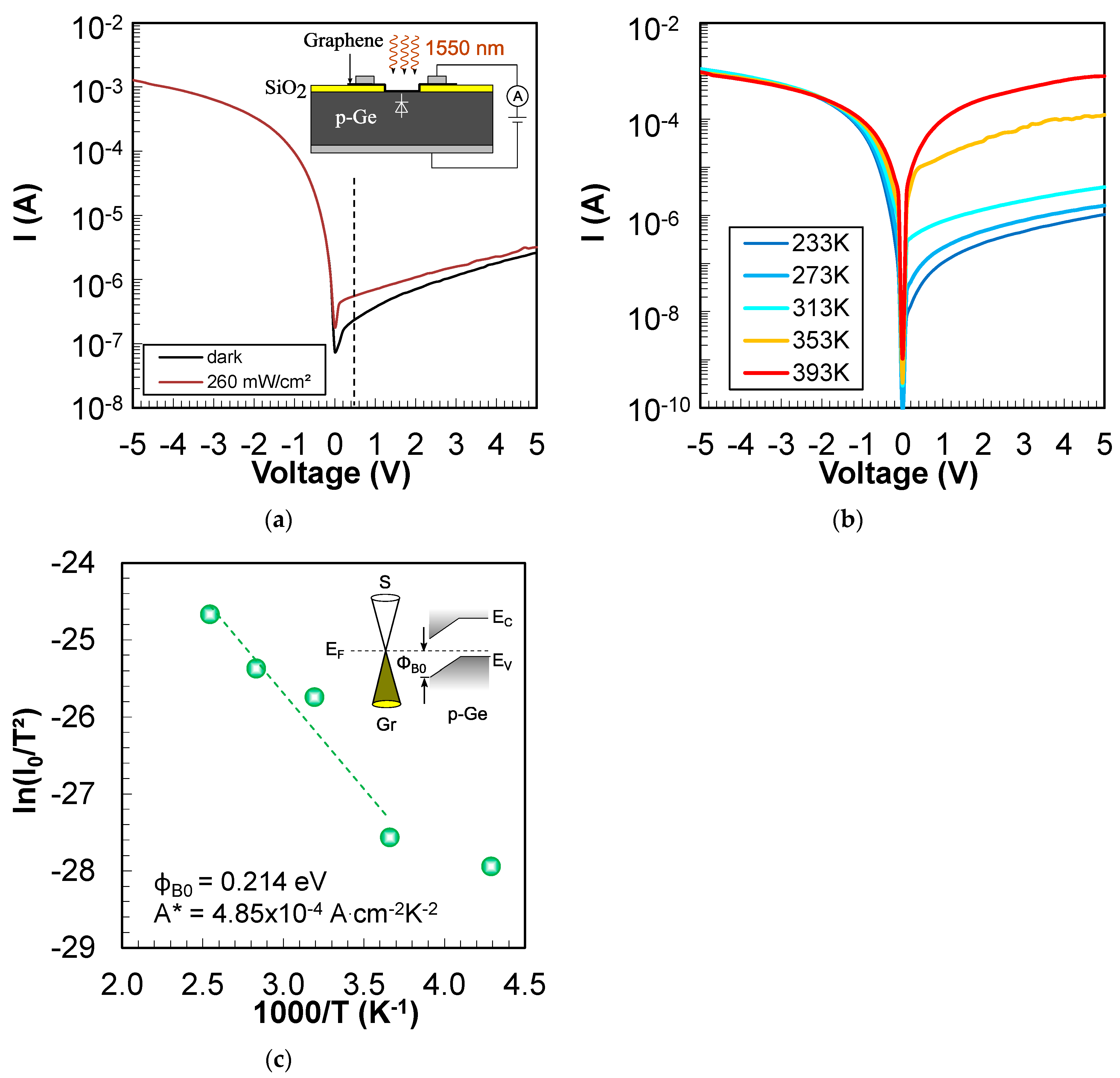
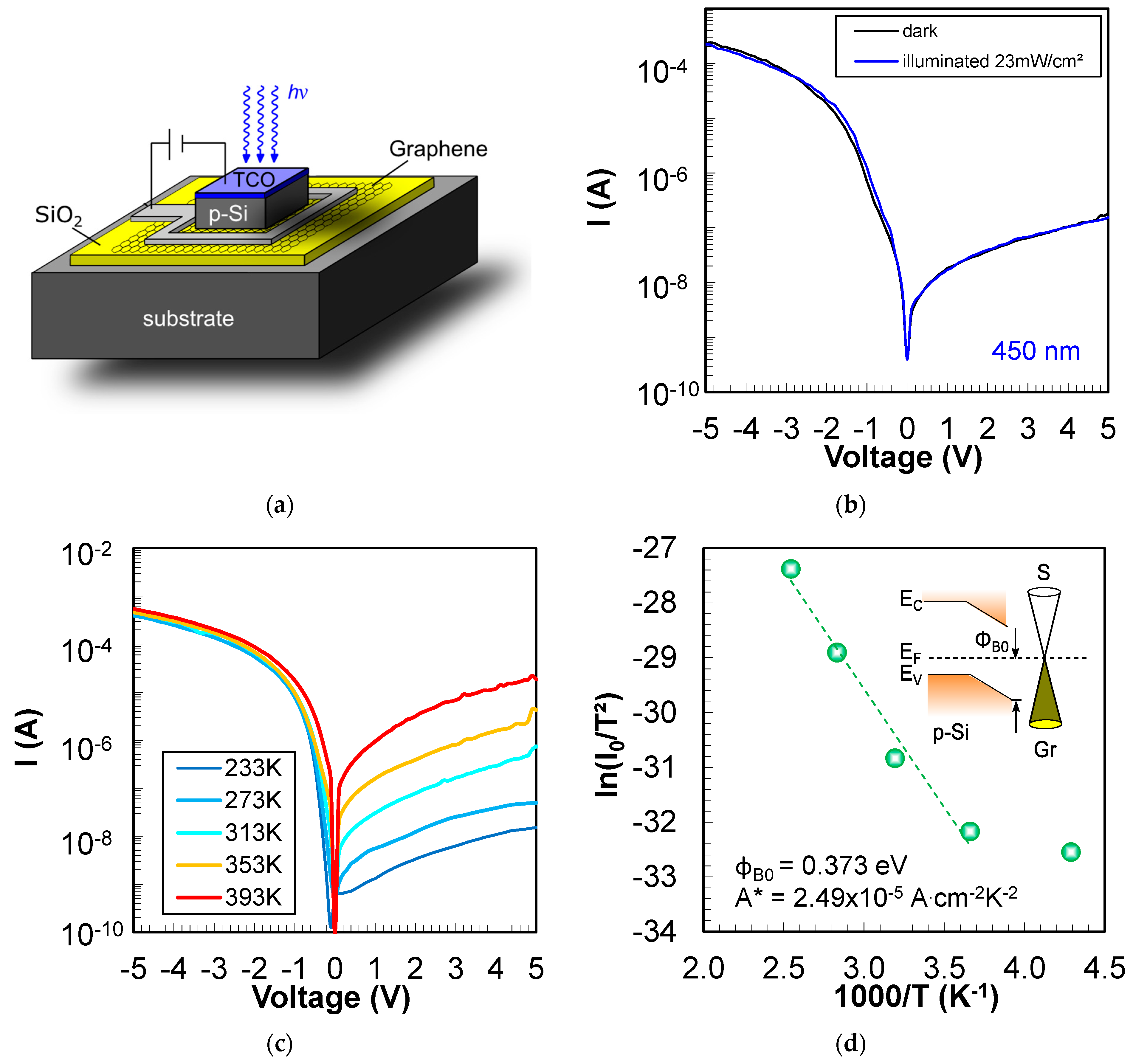
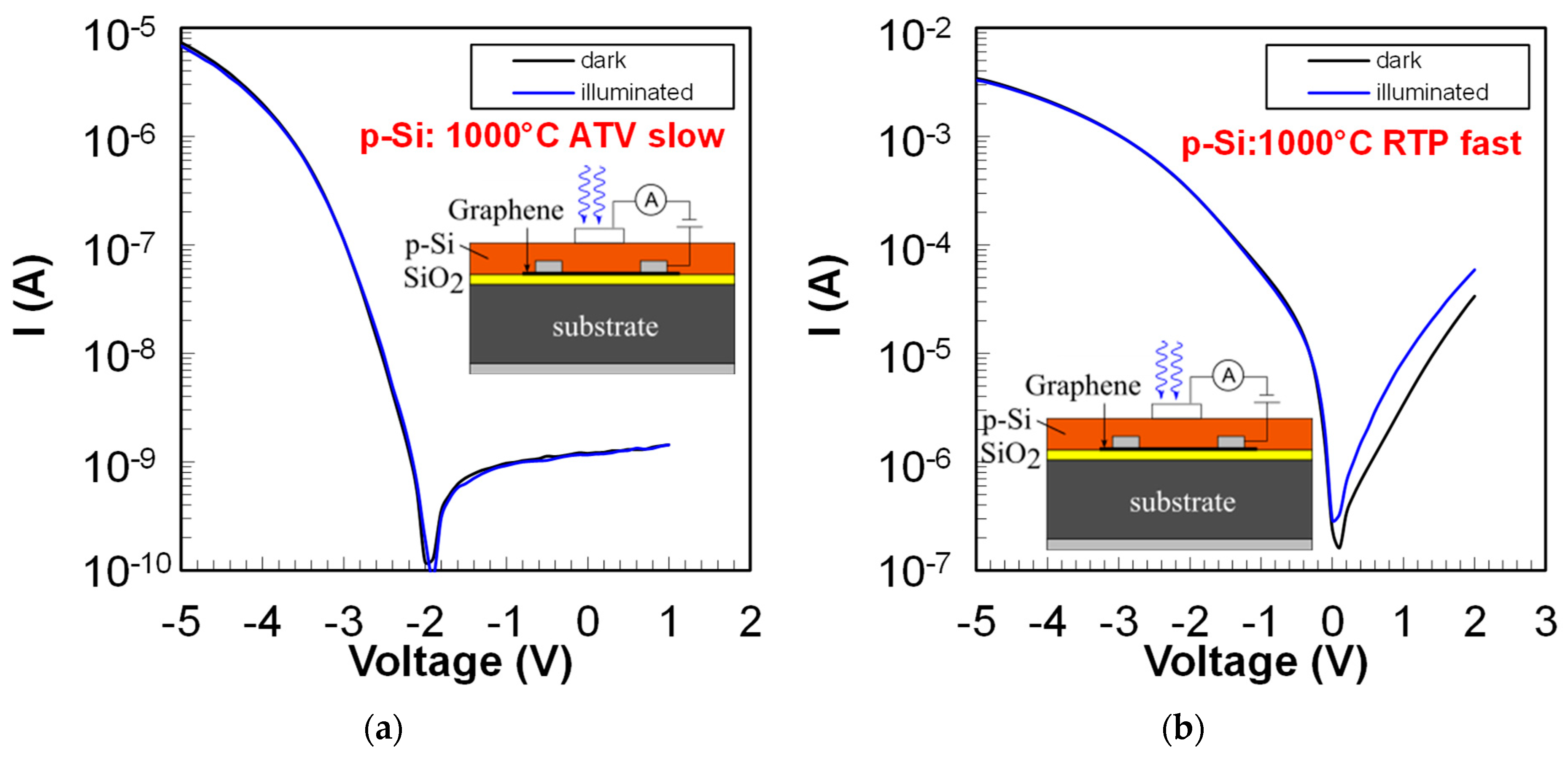
| Ref. | Phototransistor Type | Responsivity (AW−1) | Spectral Range | Bandwidth | CMOS Compatibility |
|---|---|---|---|---|---|
| [25] | Si npn | 0.6 (at 850 nm) | Broadband (400–1000 nm) | 55 kHz | High |
| [26] | SiGe waveguide | 1032 | IR (1550 nm) | 1.5 GHz | High |
| [27] | InP nanopillars on Si | 9.5 | Visible (785 nm) | 7 GHz | Medium |
| [28] | Organic semiconductors | 1.2 × 105 | Broadband (410–740 nm) | Limited | Low |
| [29] | WSe2 on hBN | 2.5 × 104 | Visible (532 nm) | Limited | Low |
| [30] | In2Se3 on Si | 41 (at 800 nm) | Broadband (405–800 nm) | Limited | Low |
| [31] | BP on Ga2O3 | 2390 (at 254 nm) | Broandband (254–808 nm) | Limited | Low |
| [32] | WSe2 on Ge | 120 (at 1550 nm) | Broadband (405–1550 nm) | Limited | Low |
| Double barrier Si/Gr/Ge | 2.8 × 108 | Broadband (532–1550 nm) | 25 GHz | Medium |
Disclaimer/Publisher’s Note: The statements, opinions and data contained in all publications are solely those of the individual author(s) and contributor(s) and not of MDPI and/or the editor(s). MDPI and/or the editor(s) disclaim responsibility for any injury to people or property resulting from any ideas, methods, instructions or products referred to in the content. |
© 2024 by the authors. Licensee MDPI, Basel, Switzerland. This article is an open access article distributed under the terms and conditions of the Creative Commons Attribution (CC BY) license (https://creativecommons.org/licenses/by/4.0/).
Share and Cite
Strobel, C.; Chavarin, C.A.; Knaut, M.; Albert, M.; Heinzig, A.; Gummadi, L.; Wenger, C.; Mikolajick, T. p-Type Schottky Contacts for Graphene Adjustable-Barrier Phototransistors. Nanomaterials 2024, 14, 1140. https://doi.org/10.3390/nano14131140
Strobel C, Chavarin CA, Knaut M, Albert M, Heinzig A, Gummadi L, Wenger C, Mikolajick T. p-Type Schottky Contacts for Graphene Adjustable-Barrier Phototransistors. Nanomaterials. 2024; 14(13):1140. https://doi.org/10.3390/nano14131140
Chicago/Turabian StyleStrobel, Carsten, Carlos Alvarado Chavarin, Martin Knaut, Matthias Albert, André Heinzig, Likhith Gummadi, Christian Wenger, and Thomas Mikolajick. 2024. "p-Type Schottky Contacts for Graphene Adjustable-Barrier Phototransistors" Nanomaterials 14, no. 13: 1140. https://doi.org/10.3390/nano14131140
APA StyleStrobel, C., Chavarin, C. A., Knaut, M., Albert, M., Heinzig, A., Gummadi, L., Wenger, C., & Mikolajick, T. (2024). p-Type Schottky Contacts for Graphene Adjustable-Barrier Phototransistors. Nanomaterials, 14(13), 1140. https://doi.org/10.3390/nano14131140








